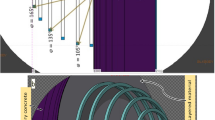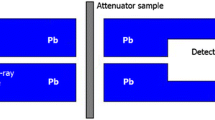Abstract
Purpose
Different types of concretes are used for bunker construction for radiation therapy. As neutron production occurs in high-energy photon beams, the purpose of this study was to investigate the effect of different concretes on photoneutron doses at an isocenter and maze entrance door.
Materials and methods
The 18-MV photon beam of a Varian 2100 C/D linear accelerator and a radiation therapy bunker were simulated using the MCNPX Monte Carlo code. Different commercially available concretes were used in photoneutron calculations for the simulated bunker.
Results
Higher neutron doses of the water phantom were seen for barytes and galena concretes, while there was no significant (less than 1%) difference between the neutron dose of the phantom for all other concretes. Also, the neutron fluence at the inner and outer maze entrance varied up to 36% depending on the concretes' atomic compositions.
Conclusion
It can be concluded that application of high-density concretes in order to use limited space or for other purposes may cause higher neutron doses in the maze entrance door and consequently may impose stricter requirements for neutron shielding of maze entrance doors.



Similar content being viewed by others
References
Facure A, da Silva AX, da Rosa LA, Cardoso SC, Rezende GF. On the production of neutrons in laminated barriers for 10 MV medical accelerator rooms. Med Phys. 2008;35(7):3285–92.
Falcao RC, Facure A, Silva AX. Neutron dose calculation at the maze entrance of medical linear accelerator rooms. Radiat Prot Dosim. 2007;123(3):283–7.
Followill DS, Stovall MS, Kry SF, Ibbott GS. Neutron source strength measurements for Varian, Siemens, Elekta, and General Electric linear accelerators. J Appl Clin Med Phys. 2003;4(3):189–94.
Naseri A, Mesbahi A. A review on photoneutrons characteristics in radiation therapy with high-energy photon beams. Rep Pract Oncol Radiother. 2010;15(5):138–44.
Allen PD, Chaudhri MA. The dose contribution due to photonuclear reactions during radiotherapy. Med Phys. 1982;9(6):904–6.
National Council on Radiation Protection and Measurements (NCRP), NCRP no. 144. Radiation protection for particle accelerator facilities. 2003.
Walter LS, editor. Monte Carlo N-particle transport code system for multiparticle and high energy applications version 2.4.0. Los Alamos National Laboratory (LANL). 2002.
Mortazavi SMJ, Mosleh-Shirazi MA, Maheri H, Zolghadri S, Haji-pour A. Production of an economic high-density concrete for shielding megavoltage radiotherapy rooms and nuclear reactors. Iran J Radiat Res. 2007;5(3):143–6.
Mortazavi SMJ, Mosleh-Shirazi MA, Baradaran-Ghahfarokhi M, Siavashpour Z, Farshadi A, Ghafoori M, Shahvar A. Production of a datolite-based heavy concrete for shielding nuclear reactors and megavoltage raditherapy rooms. Iran J Radiat Res. 2010;8(1):11–5.
Ghiasi H, Mesbahi A. Monte Carlo characterization of photneutrons in the radiation therapy with high energy photons: a comparison between simplified and full Monte Carlo models. Iran J Radiat Res. 2010;8(3):187–93.
Mesbahi A, Ghiasi H, Mahdavi SR. Photoneutron and capture gamma dose equivalent for different room and maze layouts in radiation therapy. Radiat Protect Dosim. 2010;140(3):242–9.
International Atomic Energy Agency (IAEA). Radiation protection in the design of radiotherapy facilities. Safety reports series no. 47. Vienna: IAEA. 2006.
Carinou E, Kamenopoulou V, Stamatelatos IE. Evaluation of neutron dose in the maze of medical electron accelerators. Med Phys. 1999;26(12):2520–5.
Facure A, da Silva AX, Falcao RC. Monte Carlo simulation of scattered and thermal photoneutron fluences inside a radiotherapy room. Radiat Prot Dosim. 2007;123(1):56–61.
Facure A, Silva AX, Fasolo F, Crispim VR. Neutron scattering on concrete and wood. Radiat Prot Dosim. 2006;119(1–4):514–7.
Acknowledgments
The authors would like to thank the research office of Tabriz University of Medical Sciences for supporting the current project.
Author information
Authors and Affiliations
Corresponding author
About this article
Cite this article
Mesbahi, A., Azarpeyvand, AA. & Khosravi, H.R. Does concrete composition affect photoneutron production inside radiation therapy bunkers?. Jpn J Radiol 30, 162–166 (2012). https://doi.org/10.1007/s11604-011-0030-y
Received:
Accepted:
Published:
Issue Date:
DOI: https://doi.org/10.1007/s11604-011-0030-y




